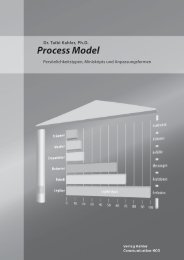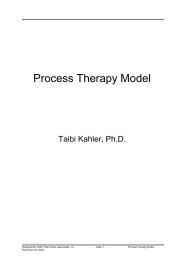Process Therapy Model - bei Kahler Communication
Process Therapy Model - bei Kahler Communication
Process Therapy Model - bei Kahler Communication
Create successful ePaper yourself
Turn your PDF publications into a flip-book with our unique Google optimized e-Paper software.
Each of these issues when not experienced in an authentic, healthy way are suppressed or<br />
repressed, resulting in the predictable cover-up racket feeling. This continues with that<br />
phase miniscript sequence behavior at a level in the person’s life that causes personal or<br />
professional problems. Once worked through to the authentic feeling, the person will<br />
phase to the next floor in their condominium.<br />
• Impasses. The T.A. term impasses was popularized by Bob and Mary Goulding. 68 They<br />
took Berne’s concept of the Adult redeciding {decontaminating), to the cathected state of<br />
the Child, thereby enhancing the significance of the experience. In my 1978 book,<br />
Transactional Analysis Revisited, I devoted a chapter to integrating degrees of impasses,<br />
and the miniscript, including structural and functional explanations and examples. 69 With<br />
the additional insights into phasing and issues, a probable impasse for each Personality<br />
phase miniscript is provided in the TASP report.<br />
• Therapeutic Impressions: Suggested phase myths, impasse issues, defense mechanisms,<br />
and the authentic emotion are offered. These are presented to be representative of this<br />
client, and of value to the therapist in identifying the specific and individualized impasses<br />
and issues.<br />
• Suggested Directions: Specific transactions, perceptions and psychological needs are<br />
identified for the therapist to use with the client. In addition, suggested therapeutic<br />
models are offered.<br />
I am excited with the discovery of phases, phasing, and issues, and gratified that therapists of<br />
the quality of Dr.’s Paul Ware and Terry McGuire have been using the model, and stating that<br />
“I find that my patients have been achieving their goals much faster.” (T. McG.).<br />
Author’s note: I openly share PTM with you, my colleagues. Please respect that the nonclinical<br />
application of this material is copyright presented and protected.<br />
©September 2004 Taibi <strong>Kahler</strong> Associates, Inc. Page 16 The <strong>Process</strong> <strong>Therapy</strong> <strong>Model</strong> ©<br />
November 28, 2005





